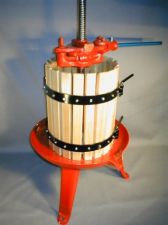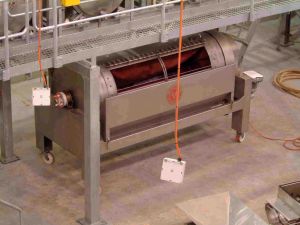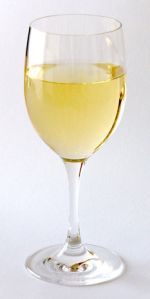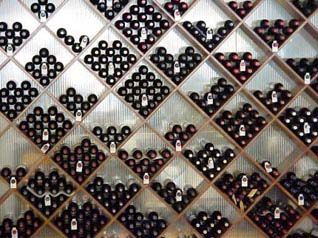|
|||||
|
|||||||
|
    An initiative of :Stichting Food-Info
|
| Food-Info.net> Food Products > Wine The steps of winemaking
|
||||||||
 |
 |
Basket press (Source) |
Willmes press (Source) |
Continuous presses are practical for production of red wines, in which skins, seeds, and juice are all fermented together. Separation of the juice is simplified because fermentation makes the skins less slippery, and the amount of free run juice obtained is, therefore, much greater than for unfermented musts. Separation of the less slippery solids from the juice by pressing is also simplified.
The drained pomace (crushed mass remaining after extraction of the juice from the grapes), from white or red fermentations, may be used to provide distilling material for production of wine spirits. Water is usually added, the fermentation is completed, and the low-alcohol wine is drained off. The pomace may be further washed and pressed or may be distilled directly in special stills.
White musts are often turbid and cloudy, and settling is desirable to allow separation of the suspended materials. Such measures as prior addition of sulphur dioxide and lowering of the temperature during settling help prevent fermentation and allow the suspended material to settle normally. In many areas wineries centrifuge the white must to remove the solids. In this process a strong pulling force is created by circular motion. Musts are sometimes pasteurised, inactivating undesirable enzymes that cause browning. The addition of pectin-splitting enzymes to the musts to facilitate pressing is uncommon. Bentonite, a type of clay, may be added to musts to reduce total nitrogen content and facilitate clarification.
There is renewed interest in the pre-fermentation heat treatment of red musts to extract colour and deactivate enzymes. This process, when performed rapidly at moderate temperatures and without undue oxidation, may be particularly desirable in the production of red sweet wines, employing short periods of fermentation on the skins; it is also suitable for use with red grapes that have been attacked by the parasitic fungus Botrytis cinerea, which contains high amounts of the polyphenol oxidase type of enzymes that cause browning.
The process of alcoholic fermentation requires careful control for the production of high quality wines. Requirements include suppression of the growth of undesirable microorganisms, presence of adequate numbers of desirable yeasts, proper nutrition for yeast growth, temperature control for prevention of excessive heat, prevention of oxidation, and proper management of the cap of skins floating in red musts.
Grape skins are normally covered with bacteria, moulds, and yeast. The wild yeasts such as Pichia, Kloeckera, and Torulopsis are often more numerous than the wine yeast Saccharomyces. Although species of Saccharomyces are generally considered more desirable for efficient alcoholic fermentation, it is possible that other yeast genera may contribute to flavour, especially in the early stages of fermentation. Saccharomyces is preferred because of its efficiency in converting sugar to alcohol and because it is less sensitive to the inhibiting effect of alcohol. Under favourable conditions, strains of Saccharomyces cerevisiae have produced up to 18 percent (by volume) of alcohol, although 15 to 16 percent is the usual limit.
Use of the yeast Schizosaccharomyces pombe has been proposed for the early stages of alcoholic fermentation. Because it metabolises malic acid, this yeast would be useful in excessively acid musts; however, commercial applications have not yielded consistently favourable results. The addition of lactic-acid bacteria to musts, using strains metabolising malic acid, is now common.
The number of undesirable microorganisms is greatest in partially rotted or injured grapes. Such damage may occur in harvesting or during transportation, particularly in warm climates. Suppression of undesirable microbial growth is required, and the most common method used is the addition of sulphur dioxide to the freshly crushed grapes at the rate of about 100 to 150 milligrammes per litre. Sulphur dioxide is more toxic to undesirable microorganisms than to desirable microorganisms. When it is used in musts, an inoculum of the desired yeast strain, usually called a pure yeast culture, is added. Musts are rarely pasteurised, although this process may be applied when they contain undesirable amounts of oxidising enzymes from mouldy grapes.
Enologists and technicians in the science of wine making do not agree on the most desirable yeast species and strain; however, strains of S. cerevisiae are generally used. The chosen strain is allowed to multiply as much as possible in sterilised grape juice and is then transferred to larger containers of sterilised grape juice, where it continues to grow until the desired volume is reached. Suitable pressed yeasts of desirable strains are added directly, avoiding the troublesome practice of building up and maintaining a pure yeast culture. About 1 to 3 percent of a pure yeast culture, or sufficient pressed yeast to provide a population of 1,000,000 cells per millilitre, is used.
Temperature control during alcoholic fermentation is necessary to (1) facilitate yeast growth, (2) extract flavours and colours from the skins, (3) permit accumulation of desirable by-products, and (4) prevent undue rise in temperature, which kills the yeast cells. Optimum temperature for growth of common wine yeasts is about 25°C, and in many viticultural areas of the cooler temperate zone, grapes are crushed at about this temperature. Fermentation is seldom started at so high a temperature, however, because it is then difficult to prevent the temperature from exceeding 30°C during fermentation.
Extraction of flavours and colours is not a problem in white musts; the crushed grape mass is usually separated from the skins before fermentation. Fermentation of white musts at relatively cool temperatures (about 10 to 15°C) apparently results in greater formation and retention of desirable by-products. An undesirable feature of such relatively low-temperature fermentations is the longer period required for completion (six to ten weeks compared to one to four weeks at higher temperatures) and the tendency for the fermentation to stop while residual sugar remains. (This is not always considered undesirable - i.e., in German wine production.) In practice white table wines are usually fermented at about 20°C.
In red wine musts, the optimum colour extraction consistent with yeast growth occurs at about 22 to 28°C. Alcoholic fermentation produces heat, however, and careful temperature control is required to prevent the temperature from reaching a point (about 30°C) where yeast growth is seriously restricted. At still higher temperatures, growth will stop completely. Modern temperature control is accomplished by the use of heat exchangers. Older methods include placing the fermenters in a cold room; using cold pipes in the fermenter; pumping the must through double-walled pipes, with cold water in the surrounding pipe; pumping the must through a sump containing cooling coils, and pumping the coolant through jackets surrounding the tank.
Contact with air must be restricted to prevent oxidation during fermentation. In very large containers, the volume of carbon dioxide given off is sufficient to prevent entry of air. In small fermenters, fermentation traps are inserted, preventing entry of air but permitting exit of carbon dioxide. These traps are particularly desirable during the final stage of fermentation, when carbon dioxide evolution is slow. Following fermentation, small amounts of sulphur dioxide are added to help prevent oxidation. Ascorbic acid (50 to 100 milligrammes per litre) is sometimes employed to reduce the oxidation and thus the amount of sulphur dioxide required as an anti-oxidant, but is not generally recommended.
The cap of skins and pulp floating on top of the juice in red-wine fermentation inhibits flavour and colour extraction, may rise to an undesirably high temperature, and may acetify if allowed to become dry. Such problems are avoided by submerging the floating cap at least twice daily during fermentation. This operation, comparatively easy with small fermenters, becomes difficult with large, tall fermenters of up to 100,000-gallon (380,000-litre) capacity. In large units the fermenting must is drawn off near the bottom and pumped back over the top. The use of small fermentation vessels permits a greater percentage of heat loss to the surrounding atmosphere, simplifying temperature control.

With appropriate must composition, yeast strain, temperature, and other factors, alcoholic fermentation ceases when the amount of fermentable sugar available becomes very low (about 0.1 percent). Fermentation will not reach this stage when (1) musts of very high sugar content are fermented, (2) alcohol-intolerant strains of yeast are used, (3) fermentations are carried out at too low or high temperatures, and (4) fermentation under pressure is practiced. Fermentation of normal musts is usually completed in ten to thirty days. In most cases, the major portion of the yeast cells will soon be found in the sediment, or lees. Separation of the supernatant wine from the lees is called racking. The containers are kept full from this time on by "topping," a process performed frequently, as the temperature of the wine, and hence its volume, decreases. During the early stages, topping is necessary every week or two. Later, monthly or bimonthly fillings are adequate.
Normally the first racking should be performed within one to two weeks after completion of fermentation, particularly in warm climatic regions or in warm cellars, as the yeasts in the thick deposit of lees may autolyse (digest themselves), forming off-odours. Early racking is not required for wines of high total acidity - i.e., those produced in cool climatic regions or from high-acid varieties. Such wines may remain in contact with at least a portion of the lees for as long as two to four months, permitting some yeast autolysis in order to release amino acids and other possible growth factors favouring growth of lactic-acid bacteria. These bacteria then induce the second (or malolactic) fermentation.
Enologists have known for some time that young wines frequently have a secondary evolution of carbon dioxide, occurring sometime after the completion of alcoholic fermentation. This results from malolactic fermentation, in which malic acid is broken down into lactic acid and carbon dioxide. The fermentation is caused by enzymes produced by certain lactic-acid bacteria.
Flavour by-products of unknown composition are also produced during this fermentation. Malolactic fermentation is desirable when new wines are too high in malic acid, as in Germany, or when particular nuances of taste and flavour are desired, as in the red wines of Burgundy and Bordeaux in France. In other regions, some producers may encourage malolactic fermentation, and others may discourage it, depending upon the particular character desired in the wine. In all regions, this second fermentation is somewhat capricious. One product, diacetyl (a flavour and aroma agent), is apparently beneficial at low levels and undesirable at higher levels.
At low temperatures, malolactic fermentation proceeds slowly, if at all. German cellars are often equipped with steam pipes, raising the temperature to encourage this fermentation. The bacteria may fail to grow because of a deficiency or complete absence of essential amino acids. Most lactic-acid bacteria growth can be inhibited by the presence of 70 to 100 milligrammes per litre of sulphur dioxide.
Excessive malolactic fermentation may produce wines too low in acidity (flat tasting) or with undesirable odours (mousy, sauerkraut, or diacetyl). Such faults may be prevented by earlier racking, filtration, and addition of sulphur dioxide.
Some wines deposit their suspended material (yeast cells, particles of skins, etc.) very quickly, and the supernatant wine remains nearly brilliant. This is particularly true when 50-gallon wooden barrels, which have greater surface-to-volume ratio than larger containers, are employed. The rough interior of wooden cooperage facilitates deposition of suspended material. Other wines, particularly in warm regions or when large tanks are used, may remain somewhat cloudy for long periods. Removal of the suspended material during ageing is called clarification. The major procedures involved are fining, filtration, centrifugation, refrigeration, ion exchange, and heating.
Fining is an ancient practice in which a material that aids clarification is added to the wine. The main processes involved are adsorption, chemical reaction and adsorption, and possibly physical movement. Proteins and yeast cells are adsorbed on fining agents such as bentonite (a type of clay formed mainly of montmorillonite) or gelatin. Chemical reactions occurring with tannins and gelatin may be followed by adsorption of suspended compounds. If an inert material, such as silica, is added to a cloudy wine, some clarification will occur simply by the movement of the particles of inert silica through the wine. This action probably occurs to a certain extent with the addition of any fining agent.
Bentonite has largely replaced all other fining agents. Such fining agents as gelatin, casein, isinglass, albumin, egg white, nylon, and PVPP (polyvinyl pyrrolidone) may be used for special purposes, including removal of excess tannin or colour.
Excessive amounts of metals, particularly iron and copper, may be present in the wine, usually from contact with iron or metal surfaces. These result in persistent cloudiness and require removal by such special fining materials as potassium ferrocyanide (blue fining), long recommended in Germany. Cufex, a proprietary product containing potassium ferrocyanide, may be used in the United States under strict control. Phytates have been used for removing iron. In modern winery operations excessive metal content is rare, mainly owing to the use of stainless steel equipment.

Filtration is another ancient practice, and early filters consisted of rough cloth-covered screens through which the wine was poured. Modern filter pads are made of cellulose fibres of various porosities or consist of membrane filters, also in a range of porosities. The pore size of some filters is sufficiently small to remove yeast cells and most bacterial cells, but filters operate not only because of pore size but also by a certain amount of adsorption. Diatomaceous earth-filter aids, commonly added to the wine during filtration, increase the functional life of a filter by retarding pore clogging.
Centrifugation, or high-speed spinning, used to clarify musts, is also applied to wines that are difficult to clarify by other means. This operation requires careful control to avoid undue oxidation and loss of alcohol during the process.
Refrigeration aids wine clarification in several ways. Temperature reduction often prevents both yeast growth and the evolution of carbon dioxide, which tends to keep the yeast cells suspended. Carbon dioxide is more soluble at lower temperatures. A major cause of cloudiness is the slow precipitation of potassium acid tartrate (cream of tartar) as the wine ages. Rapid precipitation is induced by lowering the temperature to a range of -7 to -5°C for one or two weeks. If the resulting wine is filtered off the tartrate deposit, tartrate precipitation will not usually cause clouding later.
Another method of tartrate stabilisation is to pass a portion of wine through a device called an ion exchanger. If this ion exchanger is charged with sodium, it will replace the potassium in potassium acid tartrate with sodium, making a more soluble tartrate. Usually, if the potassium content of the blend of either treated or untreated wine is reduced to about 500 milligrammes per litre, no further precipitation will occur. Exceptions may occur, however, and to be safe, tartrate and potassium contents and pH are included in the calculation. The use of ion exchange is illegal in several countries.
Many wines contain small amounts of proteins that may cause clouding either by precipitation or by reacting with copper or other metals to form aggregates that in turn form clouds. The use of bentonite removes some protein, and protein adsorption is increased if the wine is warm when fined. Pasteurisation at 70 to 82°C also can be used to precipitate proteins, but in modern practice this process is seldom employed to aid clarification.

Further reading :
More wine info: